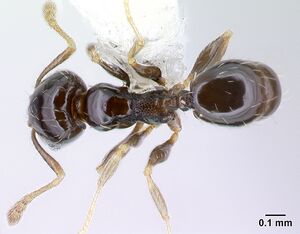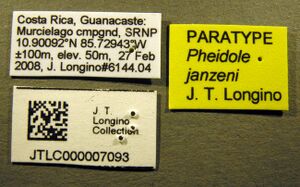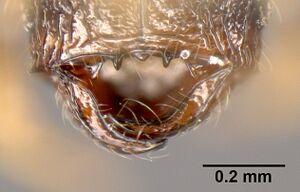Pheidole janzeni
| Pheidole janzeni | |
|---|---|

| |
| Scientific classification | |
| Kingdom: | Animalia |
| Phylum: | Arthropoda |
| Class: | Insecta |
| Order: | Hymenoptera |
| Family: | Formicidae |
| Subfamily: | Myrmicinae |
| Tribe: | Attini |
| Genus: | Pheidole |
| Species: | P. janzeni |
| Binomial name | |
| Pheidole janzeni Longino, 2009 | |
Pheidole janzeni occurs in dry forest habitats.
Identification
The morphometric profile of Pheidole janzeni is unique. The extemely small minor workers have the habitus of Pheidole laselva and Pheidole nigricula, differing from those in the more extensive foveolate sculpture on the katepisternum and propodeum, and the shorter propodeal spines. The major worker differs from those species in the presence of shallow, smooth antennal scrobes surrounded by reticulate rugose sculpture.
Distribution
Latitudinal Distribution Pattern
Latitudinal Range: 16.53333333° to 10.90092°.
| North Temperate |
North Subtropical |
Tropical | South Subtropical |
South Temperate |
- Source: AntMaps
Distribution based on Regional Taxon Lists
Neotropical Region: Costa Rica (type locality), El Salvador, Guatemala, Honduras, Mexico.
Distribution based on AntMaps
Distribution based on AntWeb specimens
Check data from AntWeb
Countries Occupied
| Number of countries occupied by this species based on AntWiki Regional Taxon Lists. In general, fewer countries occupied indicates a narrower range, while more countries indicates a more widespread species. |

|
Estimated Abundance
| Relative abundance based on number of AntMaps records per species (this species within the purple bar). Fewer records (to the left) indicates a less abundant/encountered species while more records (to the right) indicates more abundant/encountered species. |

|
Biology
Longino (2009) - In Costa Rica, minor and major workers were collected at baits near a stream edge. Similarly, minor and major workers were collected at baits in dry forest localities in Chiapas, Mexico. Habitats have been open dry areas with frequent disturbance, including a recently slashed and burned field, and an area of heavy livestock use. An isolated minor worker was collected in pine oak forest at 1100m in Guatemala. It is likely that this species is common and widespread in seasonally dry areas of Mesoamerica but has been largely overlooked due to its small size.
The type series of Pheidole mackayi was from a bait and is a mixed series, with the minor workers being this newly described species and not conspecific with the holotype major worker of P. mackayi. The collections from Costa Rica and Mexico are remarkably similar and appear identical in every respect; they show no geographic variation.
Castes
Worker
Minor
Images from AntWeb
   
| |
| Paratype Pheidole janzeni. Worker. Specimen code casent0608990. Photographer Erin Prado, uploaded by California Academy of Sciences. | Owned by CAS. |
   
| |
| Paratype Pheidole janzeni. Worker. Specimen code casent0608993. Photographer Stephanie Ware, uploaded by Field Museum. | Owned by FMNH. |
    
| |
| Paratype Pheidole janzeni. Worker. Specimen code jtlc000007093. Photographer B. Broyles, uploaded by California Academy of Sciences. | Owned by INBC. |
Major
Images from AntWeb
   
| |
| Paratype Pheidole janzeni. Worker (major/soldier). Specimen code casent0608977. Photographer Erin Prado, uploaded by California Academy of Sciences. | Owned by CAS. |

| |
| Holotype Pheidole janzeni. Worker (major/soldier). Specimen code casent0608973. Photographer J. Russ, uploaded by California Academy of Sciences. | Owned by INBC. |
  
| |
| Paratype Pheidole janzeni. Worker (major/soldier). Specimen code jtlc000007094. Photographer B. Broyles, uploaded by California Academy of Sciences. | Owned by MCZ. |
Nomenclature
The following information is derived from Barry Bolton's Online Catalogue of the Ants of the World.
- janzeni. Pheidole janzeni Longino, 2009: 40, fig. 9 (s.w.) COSTA RICA.
Unless otherwise noted the text for the remainder of this section is reported from the publication that includes the original description.
Description
Worker
Minor Measurements (paratype): HL 0.43, HW 0.39, HLA 0.11, SL 0.33, EL 0.10, ML 0.48, PSL 0.00, PMG 0.00, SPL 0.02, PTW 0.07, PPW 0.10, CI 91, SI 84, PSLI 0, PMGI 0, SPLI 5, PPI 154.
Measurements (n=6): HL 0.40-0.44, HW 0.36-0.40, SL 0.32-0.36, CI 90-91, SI 84-95.
Face smooth and shining; margin of vertex flattened with median impression; occipital carina narrow, not visible in full face view; scape with abundant suberect setae about as long as maximum width of scape; promesonotal groove absent; propodeal spines reduced to short obtuse angles; lateral face of pronotum and entire promesonotal dorsum smooth and shining; anepisternum foveolate; katepisternum with medial shiny area surrounded by foveolae; dorsal face of propodeum foveolate, posterior face smooth and shining, lateral face foveolate dorsally, smooth and shining ventrally; mesosomal dorsum with 8-12 medium-length clear (not black) erect setae; dorsal (outer) margin of hind tibia with short decumbent pilosity, no long erect hairs; first gastral tergum smooth and shining; gastral dorsum with moderately abundant, somewhat stiff erect setae; color dark brown to black.
Major Measurements (holotype): HL 0.74, HW 0.62, HLA 0.15, SL 0.32, EL 0.10, ML 0.62, PSL 0.01, PMG 0.00, SPL 0.03, PTW 0.11, PPW 0.18, IHT 0.12, OHT 0.24, CI 83, SI 52, PSLI 1, PMGI 0, SPLI 4, PPI 156, HTI 50.
Measurements (n=4): HL 0.73-0.81, HW 0.60-0.66, SL 0.32-0.36, CI 82-83, SI 51-57.
Mandibles smooth and shiny with 3–4 coarse, widely-separated longitudinal rugae on outer base, moderately abundant subdecumbent setae on dorsal surface; clypeus smooth and flat with shallow anterior notch; face with well-defined shallow antennal scrobes, medial area somewhat swollen, sloping to relatively depressed vertex lobes, scrobes smooth and shining, most of rest of face with reticulate rugose sculpture, extending to posterior margin of vertex, about 4 stronger longitudinal rugae on frontal space posterior to clypeus; in face view anterolateral margins of head slightly flaring at mandibular condyles; head with abundant short suberect setae projecting from sides of head in face view; scape smooth and shining, terete, with abundant erect setae longer than maximum width of scape; hypostomal margin gently curved; median tooth an inconspicuous short nub; inner hypostomal teeth small but distinct, slightly closer to midline than to outer hypostomal teeth; promesonotal groove absent, dorsal profile of promesonotum evenly arched; propodeal spines present, short; promesonotum smooth and shining with patch of foveolae and rugae on humeral angles; remaining mesosomal sculpture as in minor worker; dorsum of postpetiole smooth and shining; dorsal (outer) margin of hind tibia with short decumbent pilosity, no long erect hairs; pilosity abundant on mesosomal dorsum; first gastral tergite smooth and shining, with abundant erect setae; color dark brown.
Type Material
Holotype major worker. Costa Rica, Guanacaste: Santa Rosa National Park, Sector Murcielago campground, 10.90092°N 85.72943°W, ±100m, 50m, 27 Feb 2008 (J. Longino#6144.04) Instituto Nacional de Biodiversidad, unique specimen identifier CASENT0608973.
Paratypes: major and minor workers. Same data as holotype The Natural History Museum, California Academy of Sciences, EAPZ, ECOSCE, Field Museum of Natural History, Instituto Nacional de Biodiversidad, John T. Longino Collection, Los Angeles County Museum of Natural History, Museum of Comparative Zoology, Musee d'Histoire Naturelle Genève, Instituto de Zoologia Agricola, Museu de Zoologia da Universidade de Sao Paulo, University of California, Davis, ICN, National Museum of Natural History.
Etymology
This species is named for an important mentor of mine, D. H. Janzen. It may seem odd to name such a diminutive species for a giant in tropical ecology, but (1) it is a distinctive species, unlikely to be synonymized, (2) it is widespread in synanthropic habitats, and thus likely to be frequently encountered for generations to come, and (3) it is found in tropical dry forest habitats, the conservation of which Janzen has championed.
References
- Longino, J.T. 2009. Additions to the taxonomy of New World Pheidole. Zootaxa 2181: 1-90. PDF
- Varela-Hernández, F., Flores-Zapoteco, D. 2024. New Miocene Mexican amber ant (Formicidae, Myrmicinae) of the genus Pheidole Westwood, 1839. Historical Biology, pp. 1–6 (doi:10.1080/08912963.2024.2312403).
References based on Global Ant Biodiversity Informatics
- Dattilo W. et al. 2019. MEXICO ANTS: incidence and abundance along the Nearctic-Neotropical interface. Ecology https://doi.org/10.1002/ecy.2944
- Longino J. T. 2009. Additions to the taxonomy of New World Pheidole (Hymenoptera: Formicidae). Zootaxa 2181: 1-90.
- Longino J. T. L., and M. G. Branstetter. 2018. The truncated bell: an enigmatic but pervasive elevational diversity pattern in Middle American ants. Ecography 41: 1-12.
- Vásquez-Bolaños M. 2011. Lista de especies de hormigas (Hymenoptera: Formicidae) para México. Dugesiana 18: 95-133

